Welcome,
Although we don’t know who you are…a man or a woman, how old you are, what is your educational background, where you live...
Maybe you already know perfectly well the city we would like you to invite you to...
Then, if you have never heard the word ‘KRAKOW’, allow me to tell you something about this magical place.
 Why magical?
Why magical?
Surely, you’re heard about places on Earth like Delhi, Mecca, Delphes, Jerusalem, Rome and Velehrad. These are also magical cities.
According to the Hindu philosophy, there are seven centres of energy on Earth which possess special power. These are called chakras – the sacred stones. The seventh of them is situated on the hill in Krakow on which the royal castle called Wawel is built.
Maybe it is the chakra which makes the castle and the city seem so sacred, maybe this is the ‘genius loci’ which has been shaping the Krakow culture for a thousand years. For a long time, the Hindus who visit the city to experience the chakra radiation sense there a slumbering vibration, a pulsating cosmic force. The vibration emits an extraordinary magnetic aura which influences its surroundings. You have to check it yourself...how metaphysics is intertwined with life.
Kraków 'yesterday'
As the legend has it, around 7th century, at the time of king Krak’s – the founder of the city’s - reign – in the calcareous caves under the Wawel hill there lived a dragon which fed on virgins and sheep. The beast gave Krak sleepless nights...
The king’s call for help was answered by a clever shoemaker called Skuba. He sewed a sheep-shaped bag and stuffed it with sulphur – one of the natural resources from around the Kraków area.
After the snack, the dragon - tormented by a terrible heartburn –drank the water from the Vistula river for so long, until it burst into a thousand pieces, as the writer Kornel Makuszyński claims.
Nowadays, although the old-time host of the Dragon’s Cave no longer lives there, the damp chambers of his habitation are still visited by thousands of guests who, for some reason, are overjoyed to get muddy in the beast’s cave.
 The people loved their King Krak so much that after his death they built a 17-metre high mound over his burial place.
The people loved their King Krak so much that after his death they built a 17-metre high mound over his burial place.
After the king’s decease, a menacing German prince Rodrig proposed to Wanda – Krak’s beautiful, golden-haired daughter. Turned down by the princess, he was preparing to invade her lands. Then “Wanda who refused a German”, knowing that Rodryg would never leave Poland alone as long as she was alive, threw herself down into the Vistula River.
After 1949, on the territory of the Mogila village the biggest iron plan in Poland– Nowa Huta – was built by the Soviet comrades and the Polish working classes.
Just like the Wawel dragon it would poison the whole area and everyone who lived there with its fumes. It poisoned the nearby Niepołomicka Wilderness where Polish kings used to hunt, and it poisoned the old Kraków until the stone carvings began to lose their original shape. Fortunately, this is all over now, and the old Kraków has survived.
How old?

Archeologists have found many traces of settlements around the Wawel hill from the Neolithic period and the Bronze Age (4500-750 B.C.).
Our history seems to be moving faster after the year 1000 when a diocese was established and the building the cathedral was commenced.
Kraków is, first of all, the seat of Polish kings. Twenty of the rulers were crowned in our city, and sixteen are buried here.
For almost 600 years it became the capital of Poland and it grew to be an exceptionally large city.
The municipal rights granted by Boleslaw the Shy in 1257 and the plan of the city (still to be observed in its original form) account for the unusual atmosphere of the site where gothic, Renaissance and baroque buildings stand side by side. From that time also, Kraków can brag of the biggest main square in Europe – measuring 200x200 metres.
After the Roman period the city was rebuilt in the gothic style and in the year 1335 King Kazimierz the Great established the city of Kazimierz, near the Wawel castle. This is where at the end of 15th century the Kraków Jews began to settle, making the site an architecturally and culturally exceptional place. Along with the Jewish district in Prague, Kazimierz is now the only surviving Jewish district in Europe.
The Golden Age of Kraków is the Renaissance – the time when Italian artists came to Poland to rebuild Wawel and the city. They came here with the wife of King Sigismund I, the Old - Queen Bona Sforza- who also took with her bankers, merchants, doctors, apothecaries, musicians, goldsmiths, embroiderers, cooks...
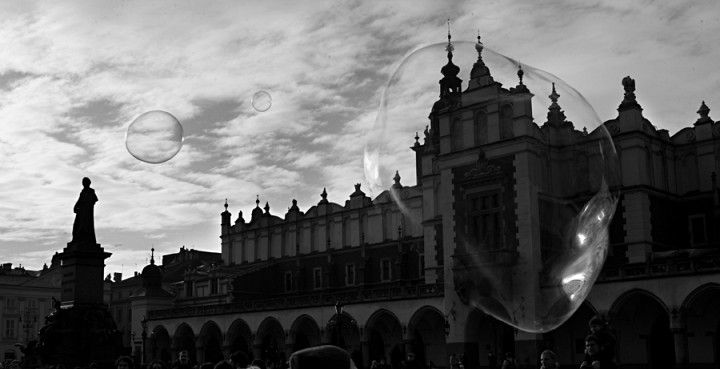
At the time Kraków came to be known as ‘Altera Roma’ – the second Rome, and ‘Renaissance Pearl of the North.’ At the time also, the Polish cuisine came to know cauliflower, parsley and celery.
Baroque brought along further architectural wonders. Also thanks to the Italian artists. But also at that time in history, the best times for the city are coming to an end.
Then, due to the Swedish connections of the Polish King Kraków ceased to be the capital of Poland. In the issuing wars the city, as well as most of the country, was looted and burnt by Swedes.
The city continued to be looted by the next invaders – Austrians and Russians. With time - it only got worse. As the Polish territory was shared between the neighbours – Prussians, Russians and Austrians – the country disappeared from the maps. In Kraków – under the Austrian rule – the Wawel chambers came to be used as military barracks and stables.
Stall, the ‘genius loci’ of the city still proved very much present even in those hard times when many countrymen would go on pilgrimages to Kraków – seeing it as the most precious national sanctuary.
Here is where history was taught, here is also where the next mould was built. This time one devoted to Tadeusz Kościuszko – who came to symbolize the invincibility of the nation and the promise of Poland’s future re-birth, which came no sooner than in 1918. When the fourth mould was made in 1934 – devoted to Józef Piłsudski – history came full circle.
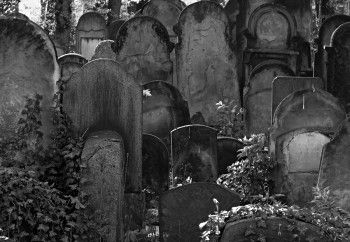 Soon after – with the outbreak on WWII - on 1st September 1939 Poland lost its newly-gained freedom to Hitler’s Germany. This was also the tragic period of the extermination of the Kazimierz Jews who were transported to Podgórze where Hitlerites created a ghetto which was the last stop for the Jewish population of the region before they were taken to the extermination camps in Auschwitz Birkenau (50 kilometres from Kraków), Bełżec, Chełmno, Sobibór and Treblinka. Just before the outbreak of the war 64 thousand Jews lived in Kraków, mainly in the district of Kazimierz. Out of the 64 thousand only a few hundred were left when the war was over. Nowadays the district is inhabited by almost 200 Jews. There are two open synagogues here (out of the 7 remaining ones), numerous monuments, museums, historic tenements and streets, mikvahs and a Jewish cemetery.
Soon after – with the outbreak on WWII - on 1st September 1939 Poland lost its newly-gained freedom to Hitler’s Germany. This was also the tragic period of the extermination of the Kazimierz Jews who were transported to Podgórze where Hitlerites created a ghetto which was the last stop for the Jewish population of the region before they were taken to the extermination camps in Auschwitz Birkenau (50 kilometres from Kraków), Bełżec, Chełmno, Sobibór and Treblinka. Just before the outbreak of the war 64 thousand Jews lived in Kraków, mainly in the district of Kazimierz. Out of the 64 thousand only a few hundred were left when the war was over. Nowadays the district is inhabited by almost 200 Jews. There are two open synagogues here (out of the 7 remaining ones), numerous monuments, museums, historic tenements and streets, mikvahs and a Jewish cemetery.
For 18 years The Festival of Jewish Culture has been taking place in Kazimierz to commemorate its original inhabitants. It is an exceptional international event first of all due to the phenomenon of the venue itself – the city of Kraków and the district of Kazimierz.
The festival is mainly a music event with many klezmer bands performing - Brave Old World, The Klezmer Conservatory Band, The Klezmatics, the Andy Statman Klezmer Orchestra. However, it also provides an opportunity for meetings, lectures, film screenings, exhibitions, Jewish dance and song, cooking, calligraphy and folk-art paper cutting workshops.
Facts
Kraków today has almost 750 000 inhabitants, 5971 historic monuments, 120 churches (out of which 87 historic ones), 88 palaces and 7 synagogues. It is the centre of national culture with hundreds of unique monuments.
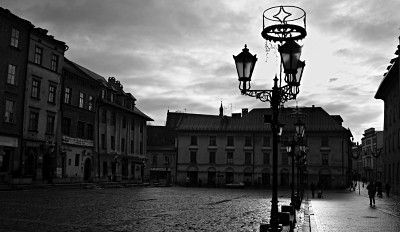 This is the city whose centre – the Wawel Royal Castle and the Jewish district of Kazimierz – was listed by UNESCO in 1978 among the 12 most precious historic sites of the world.
This is the city whose centre – the Wawel Royal Castle and the Jewish district of Kazimierz – was listed by UNESCO in 1978 among the 12 most precious historic sites of the world.
One of the most interesting sites to visit in the Kraków area is also the oldest operating salt mine in the world - Wieliczka.
In the Czartoryski Museum you’ll have the opportunity to see one of the 15 surviving Leonardo DaVinci’s paintings – ‘Lady With an Ermine.’ You can also take a look at the collection of Sigismund Augustus’ 138 renaissance arrases.
Kraków is also a city of pigeons which come here in flocks not smaller than whose you can see in Venice.
It can also brag of the largest gothic altar in the world (1489) carved for 12 years by an artist from Nuremberg - Wit Stwosz.
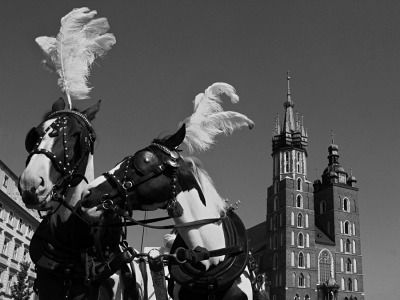 You can also see the largest main square in Europe (200x200 metres) and the largest pasture in the middle of the city, called Błonie (48 hectars) which was the place where 3 to 4 million people gathered to take part in the Papal mass of 1979.
You can also see the largest main square in Europe (200x200 metres) and the largest pasture in the middle of the city, called Błonie (48 hectars) which was the place where 3 to 4 million people gathered to take part in the Papal mass of 1979.
Kraków has been an academic centre since 1364 when one of the first universities in Europe was established here. In the Kraków Academy Nicolaus Copernicus - the scholar who came up with the heliocentric model of the Solar System - studied for 4 years.
Nowadays there are almost 170 thousand students in Kraków in almost 26 institutions of higher education among which the Jagiellonian University is the most renowned. The other outstanding institution – the Academy of Mining and Metallurgy – educates internationally acclaimed IT specialists. Kraków is also the city where the first secular high school (sill existing and working) we opened in 1588.
It is the city of poets, among them Wisława Szymborska and Czesław Miłosz who received the Noble Prize in literature. Another of the Kraków poets, later archbishop– Karol Wojtyła – in 1978 changed his name into John Paul II.
Among the world-famous writes it is necessary to mention the futurologist and philosopher Stanisław Lem and dramatist, representative the The Theatre of the Absurd - Sławomir Mrożek.
Apart from those few mentioned above, there are almost 500 other recognized and acclaimed writers living in Kraków.
Kraków is the seat of all kinds of artists – sculptors, painters, musicians, actors - and the place where you can meet them almost on every step.
Here is where Helena Modrzejewska (Helena Modjeska) was born, where the world-famous director Roman Polański spent his childhood, and where another internationally acclaimed director – Andrzej Wajda – lives. Both Polański and Wajda are Oscar winners, as is – repeatedly – Steven Spielberg – who shot his Shindler’s List partly in Kazmieierz and in the Płaszczowa quarry.
It is also the city associated with the renowned composer Krzyszfot Penderecki and the place where Nigel Kennedy – an acclaimed violist chose to live.
It’s also the heart of Polish jazz music, where Krzysztof Komeda, Andrzej Kurylewicz, Tomasz Stańko, Adam Makowicz, Zbigniew Seifert and Jan Jarczyk had their first performances.
More than that, the city of cabarets and the seat of an avangarde theatre, of the artist, stage designer and director Tadeusz Kantor “Cricot 2”.
 Many Catholic Saint are also associated with the city: Stanislaus, Jack, Queen Jadwiga, Jan Kanty, Faustyna Kowalska, Brother Albert, Simon from Lipnica and the saint ‘borrowed’ from Italy – Saint Florian – the patron of cities and firemen. Also the blessed SAlomea, Stanisław Kazimierczyk, Aniela Salawa, Bernadeta Jabłońska.
Many Catholic Saint are also associated with the city: Stanislaus, Jack, Queen Jadwiga, Jan Kanty, Faustyna Kowalska, Brother Albert, Simon from Lipnica and the saint ‘borrowed’ from Italy – Saint Florian – the patron of cities and firemen. Also the blessed SAlomea, Stanisław Kazimierczyk, Aniela Salawa, Bernadeta Jabłońska.
On the other hand, it is still the city of rabbi Moses Isserles – a renowned Talmudic scholar - who died in 1572. His grave is the place of pilgrimage for Jews all over the world.
Interestingly, the queen of cosmetics – Helena Rubinstein was born in Szeroka street.
To balance all that – Wladimir Ulianov also lived here for 2 years– the man who a few years later, under the name of Lenin, was the leader of the greatest revolution of the world – The October Revolution.
When you ask Cracovians if they are proud knowing these things about their hometown, they will modestly admit they like their city but they are really proud if their favourite soccer team wins. Because in Kraków you may be a fan of one of two local soccer teams – Cracovia or Wisła – both established in 1906.
Lately, fans of other – more sophisticated - disciplines are also heard from. Robert Kubica – the Formula 1 driver and the tennis players – Agnieszka and Urszula Radwańska - also spent their early years in Kraków.
People say that here is where ‘history is intertwined with the present-day’, where ‘life and history co-exist’, they say that this city ‘breathes history’.
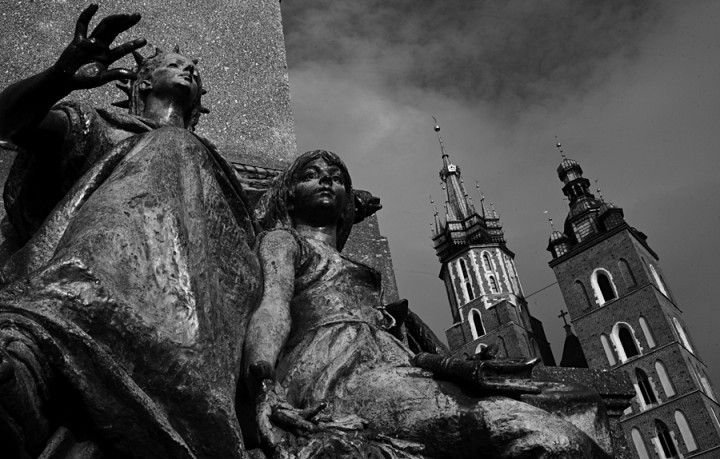 It's hard to deny that, especially if we consider the daily occurrence in Krakow – every hour you can hear a bugle call from St. Mary's Basilica (the main square church) played ‘live’ by a fireman.
It's hard to deny that, especially if we consider the daily occurrence in Krakow – every hour you can hear a bugle call from St. Mary's Basilica (the main square church) played ‘live’ by a fireman.
The call is played without the final notes to commemorate the death of the city guard who was shot with an arrow which pierced his throat while he was warning the citizens with the bugle call against the Tartar invasion in 1241. Since 1927, every day (except during the 2nd world war) you can hear the signal at high noon transmitted by the 1st Programme of the Polish Radio.
Every year around Christmas, artists – bakers, locksmiths and others who are in love with their city - bring their nativity scenes to the Adam Mickiewicz’s monument for the Nativity Scene Contest.
Afterwards, the artists give their painstakingly-prepared nativity scenes free to a museum. It is worth looking at the exhibits there just to realize how much the artists love their city!
Now a few odd facts
Two quite exceptional parades take place In Kraków: the parade of dragons and that of their more evolved relations - dachshunds.
Here, also, the largest book fair is organized.
There are also plenty of associations, including one of the world’s oldest one - established by the local craftsmen and citizens - which dates 700 years back.
Lajkonik (a man dressed as a Tartar riding a wooden horse), the garlands weaved on Midsummer’s Eve, as well as Emaus and Rękawka associated with Easter – are all unique traditions of the city. Even the students’ festival seems a special event in Kraków.
Still, Kraków is a city of many other – also quite serious festivals, like:
- Festival of Jewish Culture
- International Army Orchestra Festival
- Sacred-Profane Festival
- Misteria Paschalia Festival
- International Street Theatre Festival
- Music In Old Cracow International Festival
- Student Song Festival
- Court Dance Festival
- International Street Dance Festival
- International contest of young jazz musicians Jazz Juniors
- Jazz All Souls’ Day
- Sailors’ Song Festival
- And many, many more...
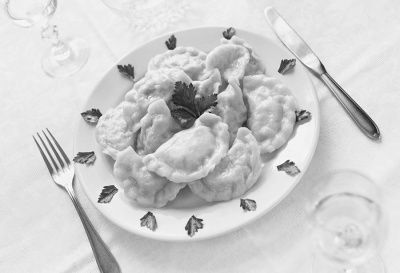 ...Along with the Kraków Pierogi Festival and International Soup Festival.
...Along with the Kraków Pierogi Festival and International Soup Festival.
The resaons
Looking back at history – a very justified thing to do here – we find something which is a perfect explanation why the 2010 LCE is supposed to take place in Kraków.
In 1983 the students of The Academy of Mining and Metallurgy organized the first Festival of Leonard Cohen Song! At that time the only such event in the world.
 In the difficult times during the martial law, just after ‘Solidarity’ was suppressed, we loved Leonard Cohen’s songs and felt they expressed our emotions quite well.
In the difficult times during the martial law, just after ‘Solidarity’ was suppressed, we loved Leonard Cohen’s songs and felt they expressed our emotions quite well.
Then came the second festival and the third in 1985, the next one didn’t take place because of the lack of funding.
Years from then, the next event – this time an international one - a great meeting of fans and friends of Leonard Cohen is about to happen.
In the fragments of interviews below you can see how close really Leonard is to Kraków.
It is his city. Here he can find his roots. It is the place of his ancestors, his tradition and culture. In all the places we told you about above, and plenty of other sites we didn’t mention, visit us here and experience the time when dawn turns into night. See the sites for yourselves and understand more...
In "alienated" Poland there was even an annual Leonard Cohen Festival at Krakow which Leonard came upon by accident, and much to his surprise, discovering in that lovely, if scarred, land not only traces his own ancestry, but also a high involvement with "seriousness" the things of the heart as his songs were translated into Polish. Great-grandfather Lazarus Cohen and grandfather Klinitsky-Klein would have been delighted - another wheel turned full circle; yet more connections
L. S. Dorman "Leonard Cohen: Prophet of the Heart"
This is a land of Chopin and Copernicus, of Solidarity, of Lech Walesa. It is also the land of Iron Guard, this is a land of Auschwitz, this is a land of many terrible atrocities. I have no judgment. My song has no flag. My song has no party. My song has no border. It is for men of good will everywhere.
Leonard Cohen from the stage in Warsaw, 1985
We were here 22 years ago. There were brave men in prison. There were people under house arrest. There was the Heavy Hand over the society and over the culture. And here today, 22 years later, they're calling this the "New Paris".
Leonard Cohen from the stage before Anjani’s concert in Trójka, 2007
I did a tour of Poland before the Solidarity government was established. I discovered that Poland was probably my largest audience in the world. Unfortunately, they paid me in zlotys, which were, as you know, not transferrable. At times when my so-called career in the West almost evaporated in most places, there was always this following in Poland and Eastern Europe. I don't know why. My great-grandfather came from Wylkowyski, which was part of Poland at the time. I was very pleased to be able to say that I came from Poland, although they really didn't think of me as Polish. It was very interesting to go there. I grew up out of that world in some way. Actually, when I arrived in Greece in 1959 or 1960, I really did feel I'd come home. I felt the village life was familiar although I'd had no experience with village life.
From the interview from 'The Jewish Book News', 1994, Arthur Kurtzweil
Ray Martin: Do you feel very Jewish?
Leonard Cohen: I know that I am a Jew and I had a good ... I came from a good Jewish family, conservative and yeah, I certainly feel that tradition deeply.
Ray Martin: Do you speak Hebrew?
Leonard Cohen: Well, I can pray in Hebrew. I can speak to the Boss in Hebrew.
Ray Martin: Did you feel especially Jewish when you went back to Poland? I read the story of your return there, which was quite an extraordinary trip, wasn’t it?
Leonard Cohen: Well, it was kind of alarming and touching experience. Well one, because there had been a very large Jewish community there of three million Jews that was destroyed in a couple years during the war. So as a Jew I felt curious because there was a lot of cooperation to be able to do away with that many people. So I did have, in that sense also, because the country is involved in some heroic struggle now, Solidarity. You do identify with their ... with their protest also. I had no idea that I had any place in the Polish culture at all, so it was kind of alarming to find the crowds there and the kind of attention I got there.
Ray Martin: Now, your parents were Polish Jews?
Leonard Cohen: My – my mother was from Lithuania which was a part of Poland and my great-grandfather came over from Poland to Canada.
Ray Martin: I read as well you were very surprised to find that there was in fact a Leonard Cohen Festival of Music in ...
Leonard Cohen: Yes, yeah. They have a festival of my songs at Krakow every year or so.
Ray Martin: Which is just near Auschwitz?
Leonard Cohen: Yeah. It’s, it’s very ... it’s very hard to deal with. I was totally unequipped for the kind of pressures that were put on me, you know, the national spokesman of Solidarity asked me to invite Lech Walesa to the Warsaw concert. He was under town confinement in Gdansk so I was invited to embarrass the Government in some way, and I didn’t have a chance to test my courage. Some of the guys in the band drew me aside and said, You know Leonard, we don’t know what weird missionary adventure (laughter) you’re on but we are just getting paid by the week, so (laughter), don’t say anything that is going to make it difficult to leave the country. Let’s play the gig and get out of town.
Fragment of the interview, soon after Cohen’s concerts in Poland in 1985
May 24, 1985 Sydney: The Midday Show With Ray Martin (ABC)
![[PREV PAGE]](but-prev.gif)
![[NEXT PAGE]](but-next.gif)
![[INDEX PAGE]](but-ndx.gif)
![[SUB INDEX PAGE]](but-subi.gif)
![[PREV PAGE]](but-prev.gif)
![[NEXT PAGE]](but-next.gif)
![[INDEX PAGE]](but-ndx.gif)
![[SUB INDEX PAGE]](but-subi.gif)